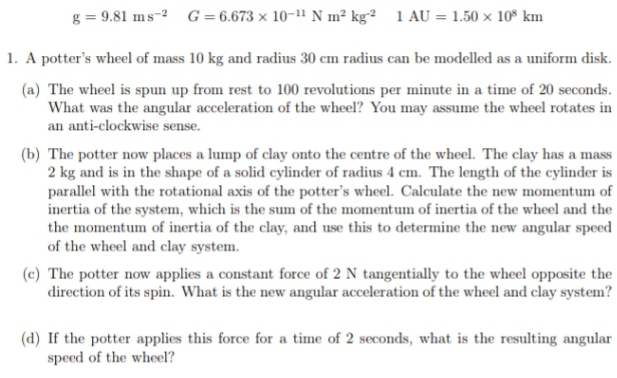1. A potter's wheel of mass 10 kg and radius 30 cm radius can be modelled as a uniform disk. (a) The wheel is spun up from rest to 100 revolutions per minute in a time of 20 seconds. What was the angular acceleration of the wheel? You may assume the wheel rotates in an anti-clockwise sense. (b) The potter now places a lump of clay onto the centre of the wheel. The clay has a mass 2 kg and is in the shape of a solid cylinder of radius 4 cm. The length of the cylinder is parallel with the rotational axis of the potter's wheel. Calculate the new momentum of inertia of the system, which is the sum of the momentum of inertia of the wheel and the the momentum of inertia of the clay, and use this to determine the new angular speed of the wheel and clay system. (c) The potter now applies a constant force of 2 N tangentially to the wheel opposite the direction of its spin. What is the new angular acceleration of the wheel and clay system? (d) If the potter applies this force for a time of 2 seconds, what is the resulting angular speed of the wheel?
1. A potter's wheel of mass 10 kg and radius 30 cm radius can be modelled as a uniform disk. (a) The wheel is spun up from rest to 100 revolutions per minute in a time of 20 seconds. What was the angular acceleration of the wheel? You may assume the wheel rotates in an anti-clockwise sense. (b) The potter now places a lump of clay onto the centre of the wheel. The clay has a mass 2 kg and is in the shape of a solid cylinder of radius 4 cm. The length of the cylinder is parallel with the rotational axis of the potter's wheel. Calculate the new momentum of inertia of the system, which is the sum of the momentum of inertia of the wheel and the the momentum of inertia of the clay, and use this to determine the new angular speed of the wheel and clay system. (c) The potter now applies a constant force of 2 N tangentially to the wheel opposite the direction of its spin. What is the new angular acceleration of the wheel and clay system? (d) If the potter applies this force for a time of 2 seconds, what is the resulting angular speed of the wheel?
Related questions
Question
Do just last part

Transcribed Image Text:g = 9.81 ms-2 G = 6.673 × 10-1" N m² kg² 1 AU = 1.50 x 10° km
1. A potter's wheel of mass 10 kg and radius 30 cm radius can be modelled as a uniform disk.
(a) The wheel is spun up from rest to 100 revolutions per minute in a time of 20 seconds.
What was the angular acceleration of the wheel? You may assume the wheel rotates in
an anti-clockwise sense.
(b) The potter now places a lump of clay onto the centre of the wheel. The clay has a mass
2 kg and is in the shape of a solid cylinder of radius 4 cm. The length of the cylinder is
parallel with the rotational axis of the potter's wheel. Calculate the new momentum of
inertia of the system, which is the sum of the momentum of inertia of the wheel and the
the momentum of inertia of the clay, and use this to determine the new angular speed
of the wheel and clay system.
(c) The potter now applies a constant force of 2 N tangentially to the wheel opposite the
direction of its spin. What is the new angular acceleration of the wheel and clay system?
(d) If the potter applies this force for a time of 2 seconds, what is the resulting angular
speed of the wheel?
Expert Solution
This question has been solved!
Explore an expertly crafted, step-by-step solution for a thorough understanding of key concepts.
Step by step
Solved in 2 steps with 2 images
